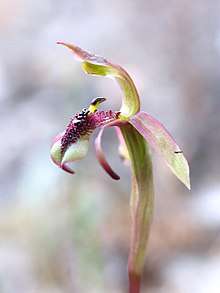Chiloglottis reflexa
Chiloglottis reflexa, commonly known as the short-clubbed wasp orchid,[2] is a species of orchid endemic to the south-eastern Australia. It has two broad leaves and a single greenish-bronze or purplish flower with an ant-like callus covering most of the top of the labellum.
| Short-clubbed wasp orchid | |
|---|---|
 | |
| Chiloglottis reflexa near Steiglitz | |
| Scientific classification | |
| Kingdom: | Plantae |
| Clade: | Tracheophytes |
| Clade: | Angiosperms |
| Clade: | Monocots |
| Order: | Asparagales |
| Family: | Orchidaceae |
| Subfamily: | Orchidoideae |
| Tribe: | Diurideae |
| Genus: | Chiloglottis |
| Species: | C. reflexa |
| Binomial name | |
| Chiloglottis reflexa | |
| Synonyms[1] | |
_in_cultivation.png)
Description
Chiloglottis reflexa is a terrestrial, perennial, deciduous, herb with two egg-shaped to elliptic leaves 20–60 mm (0.8–2 in) long and 10–30 mm (0.4–1 in) wide. A single greenish-bronze or purplish flower 22–28 mm (0.9–1 in) long and 10–12 mm (0.4–0.5 in) wide is borne on a flowering stem 60–100 mm (2–4 in) high. The dorsal sepal is spatula-shaped, 10–15 mm (0.4–0.6 in) long and 2–3.5 mm (0.08–0.1 in) wide. The lateral sepals are linear, 10–13 mm (0.4–0.5 in) long, less than 1 mm (0.04 in) wide and curve downwards. There is a glandular tip 1–2.5 mm (0.04–0.1 in) long on the end of the dorsal sepal and 1.5–3.5 mm (0.06–0.1 in) long on the lateral sepals. The petals are oblong, 8–11 mm (0.3–0.4 in) long, about 2.5 mm (0.1 in) wide and turned downwards near the ovary. The labellum is held horizontally, diamond-shaped, 8–11 mm (0.31–0.43 in) long and 5–7 mm (0.2–0.3 in) wide. The callus resembles a large black ant surrounded by thin, stalked glands and covers most of the labellum. The column has narrow wings. Flowering occurs from December to May.[2][3][4]
Taxonomy and naming
This orchid species was first formally described in 1806 by Jacques Labillardière who gave it the name Epipactis reflexa and published the description in Novae Hollandiae Plantarum Specimen.[5] In 1917 George Claridge Druce changed the name to Chiloglottis reflexa.[6] The specific epithet (reflexa) is a Latin word meaning "bent" or "turned back".[7]
Distribution and habitat
The short-clubbed wasp orchid grows in a wide range of habitats but is most common in coastal and near-coastal forest and heath. It occurs in New South Wales south from the Blue Mountains, in southern Victoria and in Tasmania.[2][3][4]
References
- "Chiloglottis reflexa". World Checklist of Selected Plant Families (WCSP). Royal Botanic Gardens, Kew.
- Jones, David L. (2006). A complete guide to native orchids of Australia including the island territories. Frenchs Forest, N.S.W.: New Holland. pp. 139–140. ISBN 1877069124.
- Jones, David L. "Chiloglottis reflexa". Royal Botanic Garden Sydney. Retrieved 22 April 2018.
- Jeanes, Jeff. ";;Chiloglottis reflexa". Royal Botanic Gardens Victoria. Retrieved 22 April 2018.
- "Epipactis reflexa". APNI. Retrieved 22 April 2018.
- "Chiloglottis reflexa". APNI. Retrieved 22 April 2018.
- Brown, Roland Wilbur (1956). The Composition of Scientific Words. Washington, D.C.: Smithsonian Institution Press. p. 139.
External links

